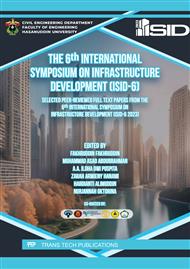[1]
M.K. Ardiansyah, S. Irawan, H.H. Purba, Identifikasi Faktor Risiko Keselamatan Pada Proyek Konstruksi Bangunan Gedung di Indonesia dalam 10 Tahun Terakhir (2011-2021): Kajian Literatur, J. Teknol. Dan Manaj. 20 (2022) 45–58.
DOI: 10.52330/jtm.v20i1.46
Google Scholar
[2]
B. Manzoor, I. Othman, A. Waheed, Accidental safety factors and prevention techniques for high-rise building projects – A review, Ain Shams Eng. J. 13 (2022) 101723.
DOI: 10.1016/j.asej.2022.101723
Google Scholar
[3]
M. Rethyna, Analisis Risiko Keselamatan Dan Kesehata Kerja (K3) Pada Bangunan Gedung Bertingkat, Ikraith Teknol. 2 (2018) 20–24.
Google Scholar
[4]
M. Elsebaei, O. Elnawawy, A.A.E. Othman, M. Badawy, Causes and impacts of site accidents in the Egyptian construction industry, Int. J. Constr. Manag. 22 (2022) 2659–2670.
DOI: 10.1080/15623599.2020.1819523
Google Scholar
[5]
V.N. Okorie, C.O. Algbavboa, The Economic and Social Impacts of Site Accidents on the Small and Medium Sized Construction Companies in Nigeria, ICIDA Conf. (2016) 163–173.
Google Scholar
[6]
Q. Sholihah, Keselamatan dan Kesehatan Kerja Konstruksi, UB Press, Malang, 2018.
Google Scholar
[7]
F. Fassa, A. Wibowo, A. Soekiman, Penyebab dan Dampak Kecelakaan, serta Solusi Keselamatan di Proyek Konstruksi Periode 2016-2020: Tinjauan Literatur, J. Tek. Sipil Dan Teknol. Konstr. 7 (2021) 111–123.
DOI: 10.25077/jrs.17.1.13-23.2021
Google Scholar
[8]
N. Tymvios, J.A. Gambatese, Perceptions about Design for Construction Worker Safety: Viewpoints from Contractors, Designers, and University Facility Owners, J. Constr. Eng. Manag. 142 (2016).
DOI: 10.1061/(asce)co.1943-7862.0001067
Google Scholar
[9]
T.M. Toole, Construction Site Safety Roles, J. Constr. Eng. Manag. 128 (2002) 203–210.
Google Scholar
[10]
H. Lingard, R.P. Zhang, N. Blismas, R. Wakefield, B. Kleiner, Are we on the same page? Exploring construction professionals' mental models of occupational health and safety, Constr. Manag. Econ. 33 (2015) 73–84.
DOI: 10.1080/01446193.2015.1016541
Google Scholar
[11]
W. Ervianto, Manajemen Proyek Konstruksi, Andi, Yogyakarta, 2005.
Google Scholar
[12]
Z.D. Wibawa, S. Hidayat, Penilaian dan Pengendalian Risiko Kecelakaan pada Pekerjaan Atap di Pembangunan Gedung Bertingkat, J. Public Heal. Res. Community Heal. Dev. (JPH RECODE) 2 (2019) 83–93.
DOI: 10.20473/jphrecode.v2i2.12517
Google Scholar
[13]
F. Siahaan, Tinjauan Tentang Pekerjaan Arsitektur Dalam Proyek Konstruksi Dengan Pendekatan Pada Bangunan Gedung Bertingkat, Scale 3 (2015) 1–16.
DOI: 10.36055/jft.v4i1.1229
Google Scholar
[14]
Republik Indonesia, Permen PUPR Nomor 10 Tahun 2021 tentang Pedoman Sistem Manajemen Keselamatan Kontruksi, Kementeri. Pekerj. Umum Dan Perumah. Rakyat (2021) 1–38.
Google Scholar
[15]
I. Project Management Institute, A Guide to the PROJECT MANAGEMENT BODY OF KNOWLEDGE, 6th ed., Project Management Institute, Pennsylvania, 2017.
Google Scholar
[16]
Y. Latief, A. Suraji, L. Sagita, R.A. Machfudiyanto, Identification of Stakeholders to Establishing Construction Safety Culture in Indonesia, MATEC Web Conf. 258 (2019) 02005.
DOI: 10.1051/matecconf/201925802005
Google Scholar
[17]
P. Zhang, H. Lingard, N. Blismas, R. Wakefield, B. Kleiner, Work-Health and Safety-Risk Perceptions of Construction-Industry Stakeholders Using Photograph-Based Q Methodology, J. Constr. Eng. Manag. 141 (2015).
DOI: 10.1061/(asce)co.1943-7862.0000954
Google Scholar
[18]
D. Zhao, A.P. McCoy, B.M. Kleiner, T.H. Mills, H. Lingard, Stakeholder perceptions of risk in construction, Saf. Sci. 82 (2016) 111–119.
DOI: 10.1016/j.ssci.2015.09.002
Google Scholar
[19]
S.R. Brown, A Primer on Q Methodology, Operant Subj. 16 (1993).
Google Scholar
[20]
C.H. Davis, C. Michelle, Q Methodology in Audience Research : Bridging the Qualitative / Quantitative ' Divide '?, J. Audience Recept. Stud. 8 (2011) 559–593.
Google Scholar
[21]
P. Zhang, H. Lingard, N. Blismas, B. Kleiner, Application of Q-methodology in studying construction stakeholders ' perceptions of OSH risks – An introduction to the preliminary stage, John V McCarthy AO, Stephen Kajewski, Karen Manley, Keith Hampson Proc. 19th Trienn. CIB World Build. Congr. Queensl. (2013) 1–12.
Google Scholar
[22]
M.P. Murniati, S.V. Purnamasari, Y. Warastuti, R. Sihombing, Alat-Alat Pengujian Hipotesis, Unika Soegijapranata, Semarang, 2013.
Google Scholar
[23]
S. Santoso, Statistik Nonparametrik, Elex Media Komputindo, Jakarta, 2010.
Google Scholar
[24]
S. Moslem, O. Ghorbanzadeh, T. Blaschke, S. Duleba, Analysing Stakeholder Consensus for a Sustainable Transport Development Decision by the Fuzzy AHP and Interval AHP, Sustainability 11 (2019) 3271.
DOI: 10.3390/su11123271
Google Scholar
[25]
J.A. Gambatese, Safety Constructability: Designer Involvement in Construction Site Safety, Constr. Congr. VI (2000) 650–660.
DOI: 10.1061/40475(278)70
Google Scholar
[26]
T.V. Kerry, N.H. Abas, H.M. Affandi, S.M. Amin, Stakeholder's perceptions on the significant factors affecting safety management implementation at construction sites, Malaysian Constr. Res. J. 13 Special (2021) 68–80.
Google Scholar
[27]
N.A. Kartam, I. Flood, P. Koushki, Construction safety in Kuwait: Issues, procedures, problems, and recommendations, Saf. Sci. 36 (2000) 163–184.
DOI: 10.1016/s0925-7535(00)00041-2
Google Scholar
[28]
R.A. Machfudiyanto, Y. Latief, Y. Indah, Interrelation between policies and safety culture on safety performance and project performance in the construction sector, IOP Conf. Ser. Earth Environ. Sci. 794 (2021).
DOI: 10.1088/1755-1315/794/1/012028
Google Scholar
[29]
N.H. Abas, Investigation of the Construction Industry Stakeholder's Perceptions of Work-Health and Safety Risk-Based Scenarios Associated with Risks, Civ. Eng. Archit. 10 (2022) 1373–1384.
DOI: 10.13189/cea.2022.100411
Google Scholar


